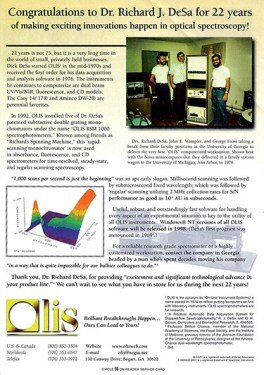Some Known Details About Uv/vis
Some Known Details About Uv/vis
Blog Article
Circular Dichroism - Truths
Table of ContentsCircular Dichroism - Truths7 Simple Techniques For Uv/visThe 20-Second Trick For Circular DichroismThe Buzz on Uv/vis/nir9 Simple Techniques For Uv/vis

Spectrophotometry is most typically used to ultraviolet, noticeable, and infrared radiation, contemporary spectrophotometers can interrogate wide swaths of the electromagnetic spectrum, including x-ray, ultraviolet, visible, infrared, and/or microwave wavelengths. Spectrophotometry is a tool that hinges on the quantitative analysis of molecules depending on just how much light is taken in by colored compounds.
The Main Principles Of Uv/vis/nir
A spectrophotometer is commonly utilized for the measurement of transmittance or reflectance of options, transparent or nontransparent solids, such as refined glass, or gases. Although many biochemicals are colored, as in, they absorb noticeable light and therefore can be determined by colorimetric procedures, even colorless biochemicals can often be transformed to colored compounds suitable for chromogenic color-forming reactions to yield substances appropriate for colorimetric analysis.: 65 However, they can also be created to determine the diffusivity on any of the noted light varieties that normally cover around 2002500 nm using various controls and calibrations.
An example of an experiment in which spectrophotometry is used is the determination of the balance constant of an option. A certain chemical response within an option may happen in a forward and reverse direction, where reactants form items and items break down into reactants. At some point, this chain reaction will reach a point of balance called a stability point.
The Single Strategy To Use For Circular Dichroism
The quantity of light that travels through the service is indicative of the concentration of certain chemicals that do not allow light to pass through. The absorption of light is because of the interaction of light with the electronic and vibrational modes of particles. Each type of particle has a specific set of energy levels connected with the makeup of its chemical bonds and nuclei and therefore will absorb light of specific wavelengths, or energies, leading to distinct spectral residential or commercial properties.
Making use of spectrophotometers covers different scientific fields, such as physics, products science, chemistry, biochemistry. UV/Vis/NIR, chemical engineering, and molecular biology. They are commonly utilized in many industries consisting of semiconductors, laser and optical manufacturing, printing and forensic examination, along with in laboratories for the study of chemical compounds. Spectrophotometry is frequently used in measurements of enzyme activities, decisions of protein concentrations, decisions of enzymatic kinetic constants, and measurements of ligand binding reactions.: 65 Eventually, a spectrophotometer has the ability to figure out, depending upon the control or calibration, what compounds are present in a target and precisely just how much through estimations of observed wavelengths.
This would come as a solution to the previously developed spectrophotometers which were unable to take in the ultraviolet properly.
The smart Trick of Circularly Polarized Luminescence That Nobody is Talking About
It would be discovered that this did not give acceptable results, for that reason in Model B, there was a shift from a glass to a quartz prism which enabled for much better absorbance outcomes - circular dichroism (https://papaly.com/categories/share?id=82b22f606fb5496cbfab4f86fdfbca1c). From there, Model C was born with an adjustment to the wavelength resolution which ended up having three units of it produced
It was produced from 1941 to 1976 where the price for it in 1941 was US$723 (far-UV devices were an alternative at extra expense). In the words of Nobel chemistry laureate Bruce Merrifield, it was "most likely the most crucial instrument ever established towards the improvement of bioscience." Once it became ceased in 1976, Hewlett-Packard developed the first commercially readily available diode-array spectrophotometer in 1979 called the HP 8450A. It irradiates the sample with polychromatic light which the sample absorbs depending upon its homes. Then it is transferred back by grating the photodiode array which identifies the wavelength region of the spectrum. Ever since, the production and execution of spectrophotometry gadgets has actually increased exceptionally and has ended up being one of the most innovative instruments of our time.

An Unbiased View of Uv/vis/nir
Historically, spectrophotometers use a monochromator including a diffraction grating to produce the analytical spectrum. The grating can either be movable or fixed. If a single detector, such as a photomultiplier tube or photodiode is utilized, the grating can be scanned stepwise (scanning spectrophotometer) so that the detector browse around here can determine the light intensity at each wavelength (which will represent each "step").
In such systems, the grating is repaired and the intensity of each wavelength of light is measured by a various detector in the selection. When making transmission measurements, the spectrophotometer quantitatively compares the fraction of light that passes through a reference service and a test solution, then electronically compares the intensities of the two signals and computes the percentage of transmission of the sample compared to the reference standard.

Report this page